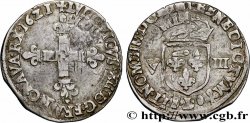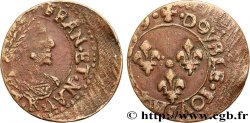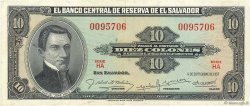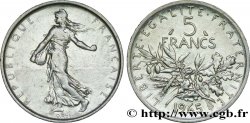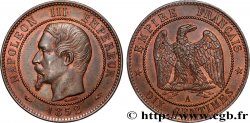E-auction 328-244723 - fme_442644 - LOUIS XIII Médaille de Cornelius Jansen
Чтобы принять участие в торгах, вы должны войти в систему и стать подтвержденным участником аукциона. Войдите, чтобы сделать ставку. Ваш аккаунт будет подтвержден в течение 48 часов. Не ждите до закрытия торгов, чтобы зарегистрироваться.Сделав ставку на данный товар, вы вступаете в юридическое соглашение на покупку выбранного товара и нажатием кнопки «Сделать ставку» подтверждаете принятие вами условий интернет-аукционов cgb.fr.
Ставка может бить сделана только в полном эквиваленте евро. Торги закроются согласно времени, указанному в описании товара, все ставки, сделанные после закрытия торгов, учитываться не будут. Не следует откладывать предложение вашей ставки до последнего момента, так как система может не успеть обработать вашу заявку, и ваша ставка не будет принята. Более детальную информацию вы найдёте здесь: FAQ по интернет-аукционам.
БЕСПЛАТНО.
БЕСПЛАТНО.
| Оценить : | 100 € |
| Цена : | 29 € |
| Максимальная предлагаемая цена : | 29 € |
| Конец торгов : | 29 July 2019 18:15:30 |
| Участников : | 5 Участников |
Тип Médaille de Cornelius Jansen
Дата: n.d.
Монетный двор / Город: Belgique, Louvain
Металл: bronze
Диаметр: 46,36 mm
Ориентация осей монеты: 12 h.
Гравер JOUVENEL Adolphe Christian (1798-1867)
Вес: 45,69 g.
Век: lisse
Пуансон: sans poinçon
Комментарии о состоянии
Intéressante médaille avec une très longue légende au revers. Patine sombre
Лицевая сторона
Аверс: легенда: CORNEILLE JANSENIUS NÉ - EN 1585 MORT EN 1638.
Аверс: описание: Buste à gauche de Cornelius Jansen.
Обратная сторона
Реверс: легенда: IL FUT PROFESSEUR / A L’UNIVERSITÉ DE LOUVAIN / ET EN 1655 LE ROI D’ESPAGNE LE / NOMMA ÉVÊQUE D’YPRES. IL S’OCCUPAIT / AVEC ZÈLE DE SON DIOCÈSE LORSQU’IL FUT / VICTIME DE LA PESTE. IL EST L’AUTEUR DE / PLUSIEURS OUVRAGES THÉORIQUES, MAIS CELUI / QUI A RENDU SON NOM CÉLÈBRE ET QUI FUT / PUBLIÉ APRÈS SA MORT EST L’AUGUSTINUS IL / L’AVAIT ÉCRIT POUR COMBATTRE LA DOCTRINE DU / JÉSUITE MOLINA SUR LA GRACE, LE LIBRE ARBITRE / ET LA PRÉDESTINATION. CE LIVRE TROUBLA / LONGTEMPS L’ÉGLISE ET DONNA LIEU A LA / QUERELLE DES JANSENISTES ET DES / MOLINISTES IL FUT CONDAMNÉ / PAR PLUSIEURS PAPES..
Реверс: Описание: Légende en 16 lignes horizontales.
Комментарий
Cornelius Jansen, plus souvent connu sous la forme latine de son nom, Jansénius, né le 28 octobre 1585 à Acquoy (Pays-Bas) et décédé le 6 mai 1638, fut évêque d'Ypres. Il est à l'origine d’un important mouvement politico-religieux, le jansénisme, condamné par l'Église catholique romaine en 1653 et persécuté par Louis XIV.
Adolphe Jouvenel, né en 1798 à Lille et mort en 1867 à Bruxelles, est un médailleur français actif à Bruxelles. Après s’être formé auprès de François Rude à Paris, Adolphe Jouvenel va s'établir en Belgique où il devint graveur du roi Léopold Ier. Il produisit de 1818 à 1860 de nombreuses médailles à sujet historiques, commémoratifs ou reproduisant le portait de personnalités de son temps..
Cornelius Jansen, more often known by the Latin form of his name, Jansenius, born on October 28, 1585 in Acquoy (Netherlands) and died on May 6, 1638, was Bishop of Ypres. He was at the origin of a major political-religious movement, Jansenism, condemned by the Roman Catholic Church in 1653 and persecuted by Louis XIV. Adolphe Jouvenel, born in 1798 in Lille and died in 1867 in Brussels, was a French medalist active in Brussels. After training with François Rude in Paris, Adolphe Jouvenel settled in Belgium where he became engraver to King Leopold I. From 1818 to 1860, he produced numerous medals on historical subjects, commemorative or reproducing the portraits of personalities of his time.
Adolphe Jouvenel, né en 1798 à Lille et mort en 1867 à Bruxelles, est un médailleur français actif à Bruxelles. Après s’être formé auprès de François Rude à Paris, Adolphe Jouvenel va s'établir en Belgique où il devint graveur du roi Léopold Ier. Il produisit de 1818 à 1860 de nombreuses médailles à sujet historiques, commémoratifs ou reproduisant le portait de personnalités de son temps..
Cornelius Jansen, more often known by the Latin form of his name, Jansenius, born on October 28, 1585 in Acquoy (Netherlands) and died on May 6, 1638, was Bishop of Ypres. He was at the origin of a major political-religious movement, Jansenism, condemned by the Roman Catholic Church in 1653 and persecuted by Louis XIV. Adolphe Jouvenel, born in 1798 in Lille and died in 1867 in Brussels, was a French medalist active in Brussels. After training with François Rude in Paris, Adolphe Jouvenel settled in Belgium where he became engraver to King Leopold I. From 1818 to 1860, he produced numerous medals on historical subjects, commemorative or reproducing the portraits of personalities of his time.







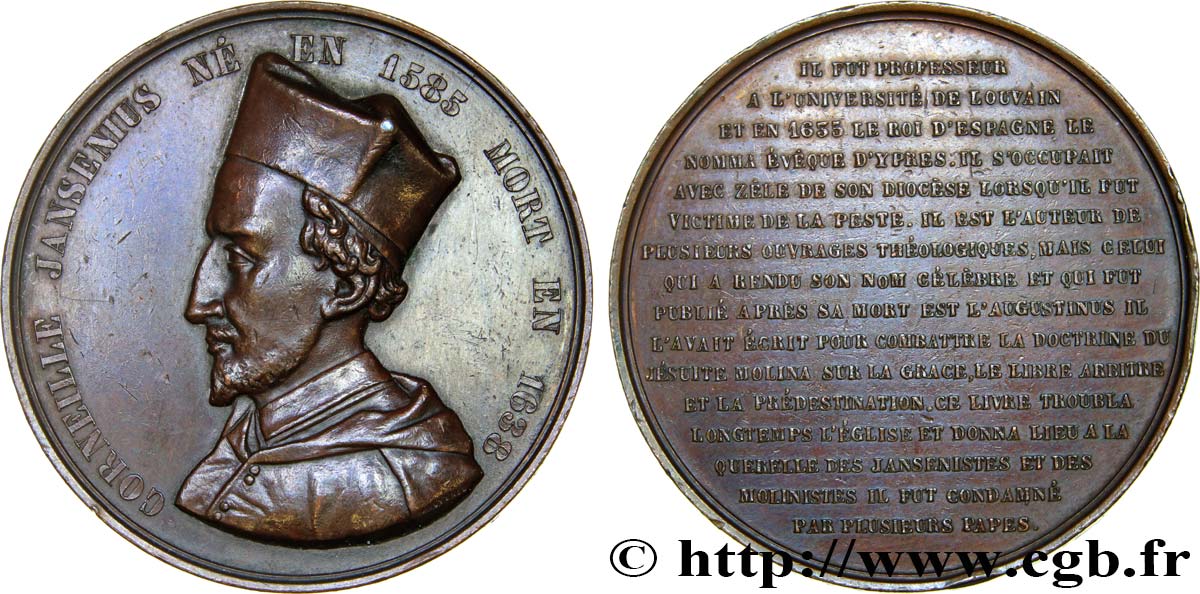
 Cообщить об ошибке
Cообщить об ошибке Распечатать страницу
Распечатать страницу Отправить мой выбор
Отправить мой выбор Задать вопрос
Задать вопрос Consign / sell
Consign / sell
 Информация
Информация
